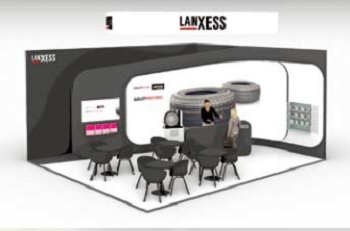Smart tyres are creating a buzz in the automotive sector. LANXESS, during the Tyre Technology Expo in Hanover (March 5-7, 2019) presented an extensive range of products and versatile solutions for manufacturing tyres. These include environmentally friendly Rhenodiv release agents, Rhenomark tyre marking paints, Rhenoshape tyre vulcanisation bladders, Rhenogran aramid-fibre masterbatches, additives, accelerators and antidegradants.
LANXESS’ Rhein Chemie business unit supplies the rubber industry with a broad portfolio of pre-dispersed polymer-bound additives, processing promoters, vulcanisation and filler activators, light protection waxes, release agents, tyre marking paints and high-performance curing bladders.
A new focus in this area is the production of “smart” tyres, specifically those low-noise and self-sealing tyres, which essentially requires that the release agents applied or transferred to the blank be removed entyrely after vulcanisation. This ensures that the polymers, foams or sensors applied subsequently will adhere properly. Such sensors can transmit important data such as tyre pressure, temperature or tread depth, and can also pass on relevant alerts to drivers or fleet operators. This improves safety considerably and helps to prevent damage to the tyres.
In addition to products containing silicone, such as Rhenodiv BP-286 and Rhenodiv BP-2864, which are removed by means of laser technology after the tyres have been vulcanised, LANXESS has developed completely silicone-free products such as Rhenodiv BP-166 and Rhenodiv BP-9500. A special type of release agent makes these even easier to wash off.
Permanently coated Rhenoshape bladders enable tyre manufacturers to vulcanise tyres with no additional release agents, eliminating the need to clean the vulcanised tyres. Since the spraying process for tyre blanks is no longer necessary, no contamination can occur – neither in critical tyre areas nor at the workplace.
Dithiophosphates – including Rhenogran TP-50 and Rhenogran SDT-50 – are nitrogen-free accelerators that can replace conventional sulfenamide, thiuram and carbamate accelerators. Their advantage is that they mainly form monosulfide and disulfide cross-links, which are more thermally stable and less susceptible to reversion. In addition, their excellent solubility enables them to be used in all common types of rubber. Rhein Chemie offers dithiophosphates not only as masterbatches under the Rhenogran brand, but also as liquid and dry liquid under the Rhenocure brand.
Rhein Chemie offers an outstanding solution for tyres exposed to high mechanical and thermal loads in the form of the Rhenogran P91-40 series. This involves highly reinforced aramid-fibre masterbatches that can be incorporated evenly into the rubber compound. Rhenogran P91-40 is suitable for use not only in typical tyre polymers such as NR, IR, BR and SBR, but also for many other types of rubber such as EPDM, CR and NBR.

RFID technology now for bladders as well
In the tyre sector, one notable innovation is the introduction of the RFID technology for tracking and managing inventories. RFID involves the use of a tiny radio transmitter (high technology transponder) and chip that are placed inside a tyre or on the outside sidewall. This transponder/chip assembly can be interrogated by a scanner that contacts it using the correct frequency and protocol.
Rhein Chemie is introducing RFID technology for bladders to improve traceability at its production sites. This involves fitting bladders with RFID tags containing information such as model name, production batch and date of manufacture. This helps to avert errors in allocating the bladders later in the process and makes them easier for customers to identify.
It is also possible to make the information stored on the RFID chip available to the tyre manufacturer. If a bladder is replaced in the tyre press, the relevant information for the new bladder can be read using an RFID reader and linked to the curing press. This prevents mistakes such as failure to reset the cycle counter. It also makes it possible to track which tyre has been cured with which bladder – information that is still not always available at present.
Air Jordan XI 11 Low













